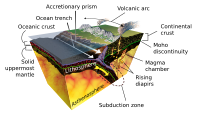
Photo from wikipedia
Abstract The safety of CO2 geological storage is a key problem that hinders its implementation. In particular, the formation dip angle and salinity can directly affect the spatial migration distribution,… Click to show full abstract
Abstract The safety of CO2 geological storage is a key problem that hinders its implementation. In particular, the formation dip angle and salinity can directly affect the spatial migration distribution, storage form and storage amount of CO2. A three-dimensional simulation model was established to evaluate the effects of the formation dip angle and salinity on the safety of CO2 geological storage. The simulation results showed that a larger dip angle resulted in a greater CO2 migration distance. The greatest CO2 migration distances with formation dip angles of 0°, 5° and 10° were 60%, 73.3%, and 86.7%, respectively, compared with a formation dip angle of 15° in the 200th year of CO2 migration. A larger formation dip angle was not conducive to CO2 geological storage. When the salinity was greater, smaller values were obtained for the CO2 liquid phase mass fraction, CO2 gas phase, liquid phase and total storage amount. With salinity values of S,3/4S,1/2S,1/4S, and 0.03, the proportions of liquid-phase storage amount in the salt-free strata were determined as 26.2%, 38.0%, 54.3%, 74.5%, and 88.1%, respectively, after CO2 migration for 200 years. Higher salinity resulted in less dissolved CO2 and decreased CO2 geological storage safety. After considering the combined influence of the dip angle and salinity, we found that the effects of the dip angle were obvious on the unit pressure and gas phase saturation, and the effect of salinity on the CO2 liquid phase mass fraction was significant. A higher dip angle and salinity greatly decreased the CO2 geological storage safety. Thus, a reservoir with a smaller dip angle and lower salinity should be selected as a site for CO2 geological storage in future studies.
Journal Title: Journal of Cleaner Production
Year Published: 2019
Link to full text (if available)
Share on Social Media: Sign Up to like & get
recommendations!